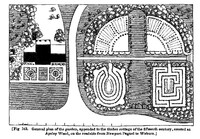To admirers of genuine Gothic forms, the following note may prove acceptable, as shewing the authorities for all the detail of this cottage [fig. 162]*.
*[Note by J. A. R. [John Adey Repton] This cottage serves as a specimen of the timber-houses which prevailed in England from about the year 1450 to 1550; that is, from the reign of Henry VI. to that of Henry VIII. As few buildings of this date remain entire, and every year reduces their number, the general plan of this cottage is not copied from any individual specimen, but the parts are taken from the most perfect fragments of the kind, some of which have since been destroyed. The hint of the lower story, being of stone, is taken from a building near Eltham Palace, except that the windows are here executed in oak instead of stone. In some buildings, both of brick and of stone, it is not uncommon to see oak windows used, as at Wolterton Manor House, East Barsham, Norfolk, and at Carhow Priory, near Norwich. Stone and brick corbels, supporting beams, may be found at Lynn Regis and at Ely. The brick-nogging between the timbers is copied from a timber-house in Lynn Regis, built by Walter Conys, in the reign of Henry VI. or Edward IV. The hint of the upright timbers being ornamented with small arches (over the centre building), was taken from a timber-house near Kelvedon, Essex, which has since been destroyed. The gable-board is copied from a house at St. Edmondsbury, and is not uncommon. The form of the pinnacles (of which few specimens now remain, being the parts most exposed to the weather,) is taken from some in brick, or stone: the only one I have ever found carved in oak is at Shrewsbury. The square flag is copied from one at Hornchurch, Essex. The projecting bow is taken from a window in Norwich, but the tracery of it is not uncommon; a specimen in oak is still to be found at Knowle, in Kent. The tracery of the lower window is taken from a timber-house in Coventry, but this, also, is not uncommon. The windows are all taken from an earlier date than the end of the reign of Henry VIII.; that is, before they were divided by a cross-bar, which did not prevail in wood till the reign of Edward VI., Elizabeth, and the early part of the seventeenth century. The design of the porch is a hint from various specimens of open porches, and particularly the cloisters of old alms-houses, or short galleries leading to dwelling-houses, as at Clapton, near Lea Bridge (since destroyed), &c. The design for the door of the cottage is taken from one remaining at Sudbury, in Suffolk. The chimneys are copied from those at Wolterton Manor House, at Barsham, Norfolk, published in the fourth volume of the Vetusta Monumenta. The ornaments painted on the posts and rails are taken from the picture of King Henry VIII. and family, now in the possession of the Society of Antiquaries.] The hints for this garden [fig. 163] have been suggested by various paintings and engravings of the date of King Henry VIII. and Elizabeth; and even the selection of flowers has been taken from those represented in the nosegays of old portraits of the same period, preserved in the Picture Gallery of Woburn.* This attention to strict congruity may appear trifling to such as have never considered, that good taste delights in the harmony of the minutest parts to the whole; and this cottage, however small, compared with modern mansions, is a tolerably fair specimen of the style and size of private houses three hundred years ago: for, although the castles and collegiate buildings were large, some of the dwelling-houses of respectable persons did not much exceed this cottage in dimensions or comfort, when one living-room was often deemed sufficient for all the family. *[The plan of this garden, as given in Forbes' Hortus Woburnensis, plate XV., differs from that here given, though not materially. Mr. Forbes has given an extract from the Red Book of Woburn Abbey, by which it appears that Mr. Repton recommended the following flowers, as still to be found in very old gardens,-viz., "Rosemary, columbine, double-crowfoot, clove-pinks, marigold, double-daisy, monkshood, southernwood, pansies, white rose, yellow lilies, turk's-cap," &c.-Hort. Wob. p. 296. J. C. L.]



